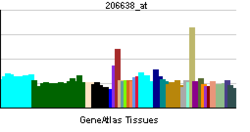5-HT2B receptor
5-Hydroxytryptamine receptor 2B (5-HT2B) also known as serotonin receptor 2B is a protein that in humans is encoded by the HTR2B gene. 5-HT2B is a member of the 5-HT2 receptor family that binds the neurotransmitter serotonin (5-hydroxytryptamine, 5-HT).
The 5-HT2 receptors (of which the 5-HT2B receptor is a subtype) mediate many of the central and peripheral physiologic functions of serotonin. Cardiovascular effects include contraction of blood vessels and shape changes in platelets; central nervous system effects include neuronal sensitization to tactile stimuli and mediation of some of the effects of hallucinogenic substituted amphetamines.
...
Wikipedia


